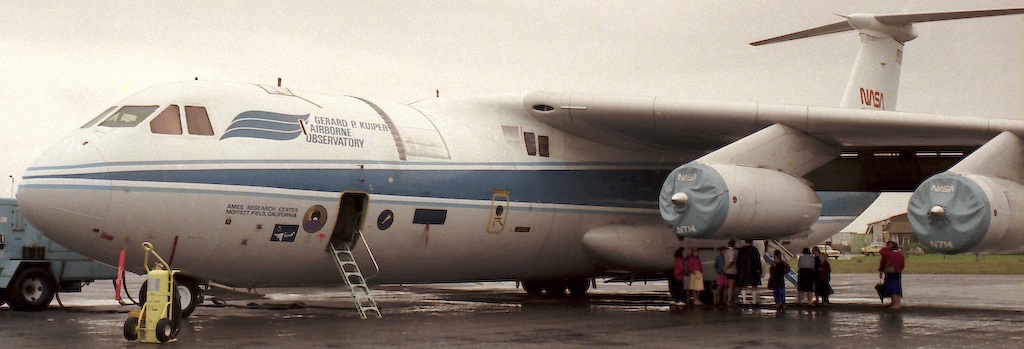Kuiper Airborne Observatory
Updated 9 November 2023

Introduction
The Gerard P Kuiper Airborne Observatory (KAO) was a Lockheed C141 StarLifter aircraft operated by NASA and modified to carry a 91 cm reflecting telescope designed for operation in the infrared part of the spectrum. It was based at the Ames Research centre, NAS Moffett Field, Sunnyvale, California. The aircraft operated as an infrared observatory from 1975 to 1995.
The KAO has been replaced by a Boeing 747SP observatory, the Stratospheric Observatory for Infrared Astronomy, SOFIA. A useful description of this new aircraft is here. The development and operation of SOFIA is jointly the responsibility of the following organisations:
- Universities Space Research Association (USRA) SOFIA Science Center
- German Sofia Institute (DSI) Deutsches SOFIA Institut
- National Aeronautics and Space Administration (NASA) SOFIA
The following description of the KAO and a flight starting from Christchurch in New Zealand was written in 1986. One of the aims of the flight was to observe methane near Halley's comet. Doppler shifts in the spectrum would allow this methane to be distinguished from terrestrial methane. I was an guest on this flight representing the New Zealand Department of Scientific and Industrial Research (DSIR). The flight photos were shot on film in very low levels of ambient light.
Flight on the Gerard P Kuiper Airborne Observatory, Christchurch, 20 March 1986
Flight is at 39000 to 45000 feet, which is above at least 99% of terrestrial water vapour. The telescope is installed in the fuselage on the port side, just ahead of the wings. When in use, a cover is removed and the telescope is exposed to very low temperatures and pressures, which means that stable materials such as Cervit and Invar are used in its construction.
The telescope is a 91 cm f/2 Cassegrain design with a 23cm secondary mirror figured to yield an overall focal ratio of f/13.5. It is possible to oscillate this secondary mirror at frequencies of up to 140 Hz for background correction purposes. The reflected beam of light is bent by an auxiliary mirror to a focus in the cabin of the aircraft. Experiments can be mounted at this point by various research groups by means of a standard adapter plate.
Counter weights are added to restore balance to the telescope. The telescope is mounted on compressed air bearings and is controlled by a sophisticated servo system capable of pointing the telescope to within a few seconds of arc. Elevation of the telescope is possible over the range from 35 to 75 degrees. This range is limited because the aircraft structural strength must be preserved. In practice this limitation is overcome by flying the aircraft to a suitable global location.
The telescope is pre-cooled before flight and the cavity purged with nitrogen to ensure optimum performance when exposed at flight altitude to temperatures of about -45 C.
The Flight
On this flight, a group led by Harold P Larson from the Lunar and Planetary Laboratory, University of Arizona, had just installed their Infrared Fourier Spectrometer on the telescope. The Spectrometer is a Michelson interferometer based on concepts developed by Pierre Connes of the Centre National de la Recherche Scientifique in France. The instrument has a variable resolution from 250 to 0.01 cm-1 over the range from 0.8 to 5.6 um using liquid nitrogen cooled InSb detectors. This performance is maintained in the adverse vibrational environment of the KAO observatory.
Take off was from Christchurch airport at 22.46 hrs in a south-westerly direction. The aircraft climbed to 39400 feet on this leg before turning north-east, near the Waitaki river.
Alpha Hydra
The first object, Alpha Hydra, was acquired for observation. This is the brightest star in the constellation of hydra and was being used to provide a continuum for calibration purposes. This leg proved to be slightly more northerly than the flight plan and actually passed over Wellington. This was because the windspeed was less than predicted.
The wind data at 40000 feet for the flight plan was obtained from a global weather model based in England. A continuously curving flight path was necessary to keep the star within the +/- 3 degree lateral movement allowed for the telescope.
R Crateris
Just north of Wellington, at 00.30 hrs, a small change of course allowed the star R Crateris in the constellation of Crater to be observed. This is a low-temperature star and an IR band spectrum between 2 and 3 microns was obtained. The species CO, molecular hydrogen, water and helium were apparent in the spectrum. Signal averaging over the next hour produced data of high quality for later analysis in the USA. The experiments were all computer controlled according to a preset programme. The scientists were there to make adjustments where necessary.
Computer data tapes were produced using the observatory computers linked into the scientists experimental package. Observations of the regions adjacent to a star are often rich in IR energy as these represent heated dust and gas shells around the star. Contributions by residual terrestrial gases are removed by allowing for doppler shifts.
Eta Carinae
Nearly 500 miles east of Whangarei, at 01.35 hrs, the course was changed to a north-westerly heading to acquire the star Eta Carinae in the constellation of Carina. This is a variable star with a rich infrared emission. In 1833 this star had a magnitude of -0.7 being the second brightest in the sky. It has since faded to magnitude 7, not observable to the naked eye. A very distinct spectrum was obtained with several sharp lines even though this was only one of many scans to be averaged. Species observable were hydrogen, terrestrial water and CO2 as absorption bands, Iron, and Helium all superimposed on a dust continuum. The spectrum covered the range 3800 to 5200 cm-1.
G333.6
About 500 miles due north of Auckland, at 03.11 hrs, the plane's course was changed to a south westerly direction to observe an unnamed star, G333.6. This is a young stellar object not visible at all with a temperature lower than 2000 C. It is believed to be at the stage where it is blowing off gas and dust clouds, perhaps as a prelude to planetary formation. In this case the single sweep spectrum showed nothing distinct except perhaps molecular hydrogen. The star was locked onto by using a plotted overlay of neighbouring stars superimposed on the video screen. By matching the star images to the overlay the object was found.
Halley's Comet
About 250 miles north-west of North Cape, at 04.17 hrs, the plane turned due south to observe Halley's Comet. The object of this experiment was to look for methane in the coma. The spectrum was not strong but lines thought to be either terrestrial or cometary methane were observed. Definitive results will be obtained when doppler shifts of the lines are calculated, since the comet is a moving body. On an earlier flight water was detected and mapped.
I was able to observe the comet visually from the flight deck, using a pair of 10x50 binoculars I brought along. The image was clear and one of the astronomers noted that there was little structure to the tail as is the case with some comets. The binoculars proved to be very popular on this leg in spite of good images on the VDU screens. All the world-renowned astronomers and the aircraft crew borrowed them.

Landing
At 06.00 hrs the plane turned east over the main divide for an approach to Christchurch airport to land at 06.30 hrs.
20 years of service celebration
The Mission Commander, Bob Cameron, celebrated his last flight and more than 20 years of flying telescope operations with glasses of champagne all round. He was one of the principal proponents and designers of the flying telescope concept with earlier operations since 1965 in a Convair 990 and a Lear Jet with telescopes of up to 30cm aperture. Proposals in hand include a 3-metre telescope to be flown in a 747 aircraft at 45-47000 feet.
Altitude and temperature
On this flight, altitude gradually increased during the flight from 39000 feet to a maximum of 43000 feet on the Halley leg. Some problems with the aircraft temperature control were dealt with manually by venting heat at the end of each leg.
Organisation
I was impressed with the organisation and planning of this operation. The NASA staff operated the telescope efficiently and provided a high percentage of observation time for scientists using the facility. Technical problems were dealt with in such a way as to minimise the effect on observations. For example, one of the telescope gyros took 1 hour and 20 minutes to come up to speed before the flight instead of 3 minutes. The flight still took place with the servicing presumably postponed to the next day. This decision minimised the impact on the scientists' program even though it would have been valid to have attended to the problem immediately.
Other minor faults cropped up during the flight and were dealt with in a similar way or by immediate manual intervention. Visitors were made welcome and in return we respected the need of staff and scientists to concentrate on their duties. A noise level of 120db made conversation difficult except via the headsets. These were reserved primarily for staff and scientists but we were able to listen in.
Scientific Investigators
Scientists of note on this flight included Scott Davis and Mike Williams from the university of Arizona. Scott Davis operated the interferometer and, with Mike Williams, was responsible for the original design of the interferometer. Reiner Hoffman and Sigfried Drappatz were astrophysicists from the Max Plank Institute in Munich. Mike Mumma was the head of the Planetary Systems Branch at NASA's Goddard Space Center and Harold Weaver was from John Hopkins University. They both devised a theory that parent molecules could be best detected by measuring the infrared fluorescence spectrum stimulated by sunlight rather than by inference from species such as atomic hydrogen and oxygen, OH- and H2O+. The theory predicts in precise detail the wavelength and relative line intensities. For water 10 lines were predicted.
On 23 December 1985, on a KAO flight out of the Ames Research centre in California, they detected all 10 lines using the University of Arizona interferometer. This is the first confirmation that neutral water is the dominant species and lends weight to Fred Whipple's dirty snowball theory of comets. In New Zealand they hope to extend this work to methane. The comparison with the, as yet unreleased, results from Giotto will be interesting.
Significant KAO Results
Notable results from previous KAO flights include the discovery of the rings of Uranus and H2O in the atmosphere of Jupiter as well as important results outlining stellar formation, gas cloud dynamics and compositions, dynamics of planetary atmospheres and emission line work in the interstellar medium.


JEPSPECTRO - Home Page
Email: replace at with @
jepattersonatactrix.co.nz
JEP Related Links
About the KAO
KAO 30th anniversary
Live from the Stratosphere
NASA's Kuiper Airborne Observatory, 1971-1995
Cosmic Ray Telescope
SOFIA
Click the photos below to enlarge. Use the browser "back control" to return.
 Telescope control console.
Telescope control console.
 HP computers and atmospheric water experiment, looking aft.
HP computers and atmospheric water experiment, looking aft.
 Flight plan.
Flight plan.
 Eta Carinae Star field - screens are written on and the rags are for cleaning them.
Eta Carinae Star field - screens are written on and the rags are for cleaning them.
 Experimental data on chart recorders.
Experimental data on chart recorders.
 Left: experiment patch panel - right: HP computers.
Left: experiment patch panel - right: HP computers.
 FTIR mounted on bent Cassegrain focus. Air bearings at left and right.
FTIR mounted on bent Cassegrain focus. Air bearings at left and right.
 Halley's Comet.
Halley's Comet.
 Astronomer, Scott Davis collecting data.
Astronomer, Scott Davis collecting data.
 Daylight, before landing.
Daylight, before landing.
 Bob Cameron, 20 years of service.
Bob Cameron, 20 years of service.
 KAO cockpit.
KAO cockpit.